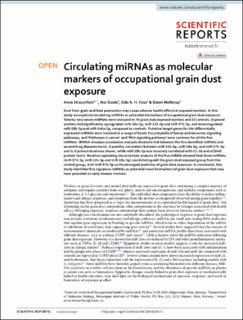Circulating miRNAs as molecular markers of occupational grain dust exposure
Peer reviewed, Journal article
Published version
Permanent lenke
https://hdl.handle.net/11250/2992497Utgivelsesdato
2020Metadata
Vis full innførselSamlinger
Originalversjon
10.1038/s41598-020-68296-5Sammendrag
Dust from grain and feed production may cause adverse health effects in exposed workers. In this study we explored circulating miRNAs as potential biomarkers of occupational grain dust exposure. Twenty-two serum miRNAs were analyzed in 44 grain dust exposed workers and 22 controls. Exposed workers had significantly upregulated miR-18a-5p, miR-124-3p and miR-574-3p, and downregulated miR-19b-3p and miR-146a-5p, compared to controls. Putative target genes for the differentially expressed miRNAs were involved in a range of Kyoto Encyclopedia of Genes and Genomes signaling pathways, and ‘Pathways in cancer’ and ‘Wnt signaling pathway’ were common for all the five miRNAs. MiRNA-diseases association analysis showed a link between the five identified miRNAs and several lung diseases terms. A positive correlation between miR-124-3p, miR-18a-5p, and miR-574-3p and IL-6 protein level was shown, while miR-19b-3p was inversely correlated with CC-16 and sCD40L protein levels. Receiver-operating characteristic analysis of the five miRNA showed that three miRNAs (miR-574-3p, miR-124-3p and miR-18a-5p) could distinguish the grain dust exposed group from the control group, with miR-574-3p as the strongest predictor of grain dust exposure. In conclusion, this study identified five signature miRNAs as potential novel biomarkers of grain dust exposure that may have potential as early disease markers.
